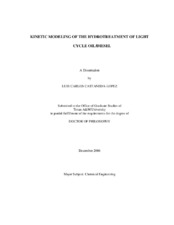| dc.description.abstract | A rigorous kinetic model of hydrodesulfurization (HDS) of complex mixtures such
as light cycle oil (LCO) or diesel has been developed. An experimental setup was
constructed to investigate the hydrotreatment of complex mixtures. The
hydrodesulfurization of LCO on a commercial CoMo/Al2O3 (IMP) catalyst was
investigated in a Robinson Mahoney perfectly mixed flow stationary basket reactor. An
experimental investigation of the HDS of the dibenzothiophene (DBT) and substituted
dibenzothiophenes in the LCO was carried out at temperatures between 290 and 330°C,
space time for dibenzothiophene (W/F0
DBT) between 1000 and 6500 kgcat-h/kmol, and
H2/HC molar ratio constant of 2.8. To avoid having to deal with a huge number of
parameters in the model, a methodology based on structural contributions was applied.
DENs and DENt are the denominators of the Hougen-Watson rate expressions for
hydrodesulfurization of dibenzothiophene (DBT) and methyl-substituted
dibenzothiophenes contained in the LCO. Both denominators comprise the concentration of all adsorbing species of the LCO multiplied by their adsorption equilibrium constants.
The estimation of the denominators DENs and DENt was performed using the
Levenberg-Marquardt algorithm and the results in terms of conversion for DBT,
biphenyl and cyclohexylbenzene obtained in the hydrodesulfurization of the LCO. The
evolution of DENs and DENt values with the composition was calculated for each LCO
experiment.
Structural contributions were taken from Vanrysselberghe and Froment for
hydrogenolysis and hydrogenation of methyl-substituted dibenzothiophenes with a
significant reduction in the number of parameters to be estimated in the HDS of the
LCO.
The multiplication factors, fsDBT, which are products of structural contributions for
hydrogenolysis and hydrogenation of the mono- and dimethyl-dibenzothiophenes were
also taken from Vanrysselberghe and Froment. These multiplication factors are based on
experimental results with model components such as DBT, 4-Methyl dibenzothiophene
and 4,6-Dimethyl dibenzothiophene.
The results obtained in the modeling are in good agreement with the experimental
data because the model reproduces very well the observed total conversions of DBT,
conversions of DBT into biphenyl and conversions of DBT into cyclohexylbenzene as a
function of temperature. | en |


